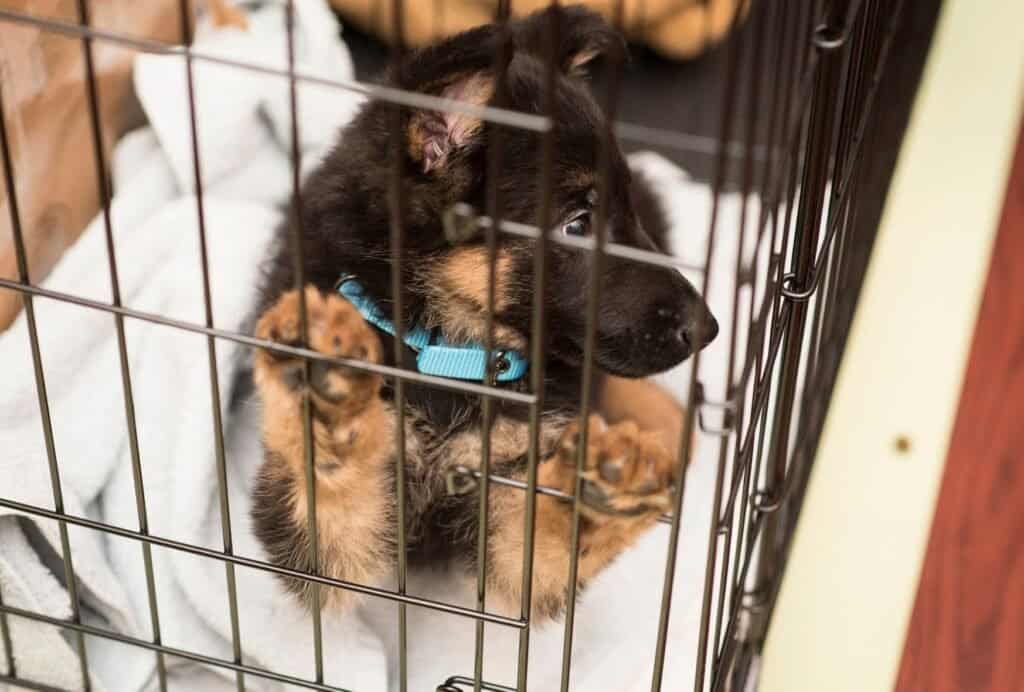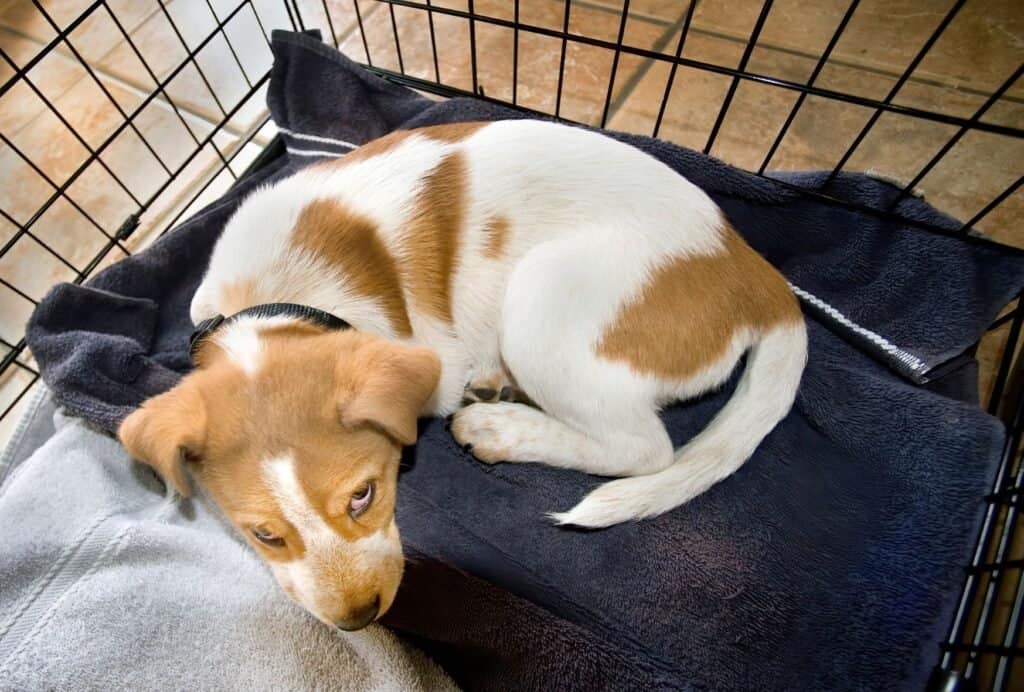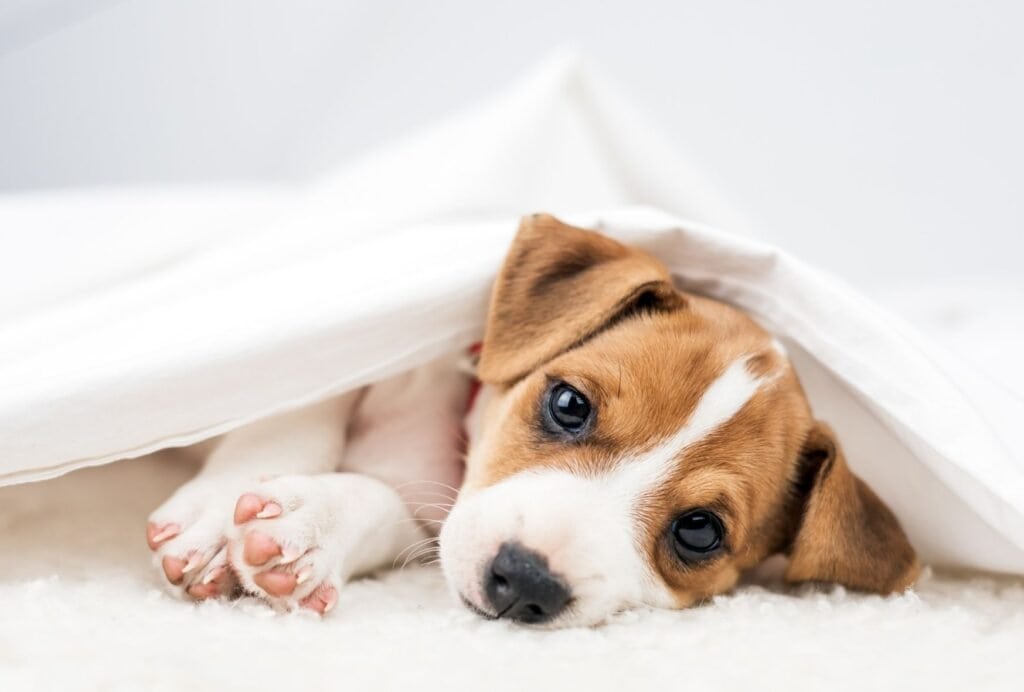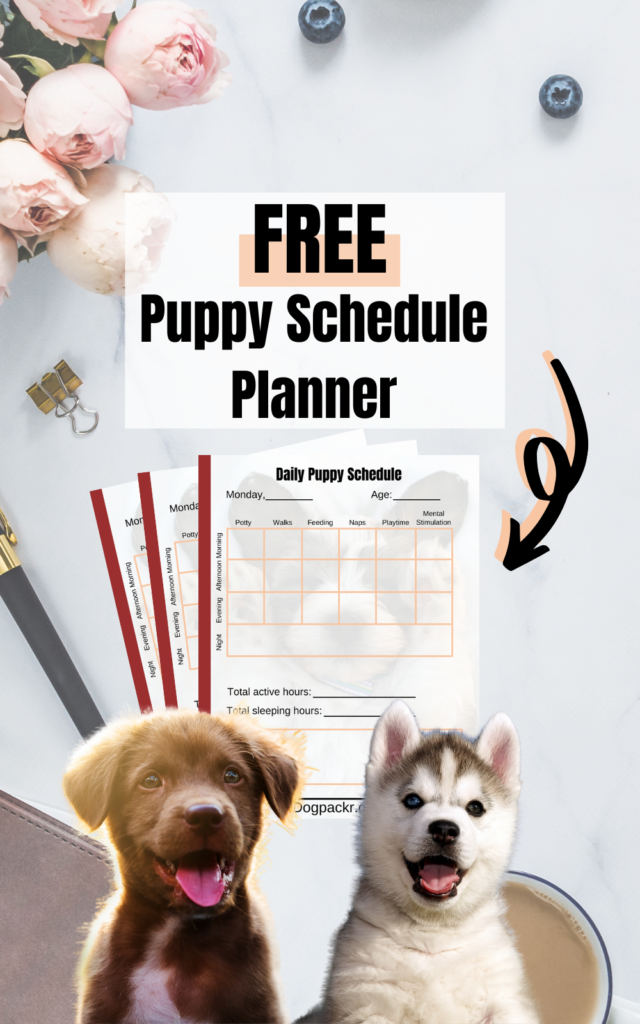
If you’ve just recently gotten your puppy, crate training is likely top of mind.
Whether you use it to potty train your little fur ball or simply to help him calm down, crates can be incredibly useful to train your puppy into a well-behaved and calm dog.
Dogs love routine more than anything else. This is why it’s a very good idea to start implementing a daily routine as early as possible. And the best way to get started with that is by setting up a crate training schedule.
So, in this article you’ll learn what’s a good crate training schedule for a puppy.
Table of Contents
How to Crate Train a Puppy
Crates get a bad rap. Lots of dog owners refuse to crate train their dogs because they’re worried it’s cruel.
The reality is that as long as you crate train your dog properly, crates are great tools for you and your dog! They give your dog a safe space to hide out, and when your dog is crated while you’re out, you don’t have to worry about him getting into anything he shouldn’t.
So how do you crate train your puppy? Let’s get into it.

What’s the Best Crate for a Puppy?
The first thing you need to do is make sure you’re selecting the right crate. The crate should work for both you and your dog.
Remember to choose the right size crate. As a general rule of thumb, your dog should have just enough room in his crate to stand up and turn around fully.
If you’re crate training your puppy, you’ll probably have to buy a smaller crate and upgrade later once he’s fully grown.
For some tips on choosing the right crate and some of the best crates on the market, check out my article about the 6 best crates for dogs to sleep in.
Puppy Crate Training Tips
As you start crate training your dog, there’s something important to remember. Every dog is different, and some take better to crate training than others.
It can be frustrating at times, but remember to be patient, consistent, and go at your dog’s own pace. You want his crate to be a positive space where he feels safe and calm, and it should never be stressful for him to go in there!
Training a dog in general is the easiest while he’s still a puppy. There are several ways to do that. But the most cost-effective is definitely to get an online course.
I’ve spent hundreds – if not thousands – of dollars on dog training classes and private dog trainers. In most cases, that’s not necessary at all, though. You can get the exact same information in an online course.
My all time favorite course is Braintraining4dogs. It’s based on positive reinforcement and focuses on improving your dog’s intelligence so that he can basically solve his own problems.

1. Set up the crate
When you start crate training, the very first thing to do is, of course, set up the crate. When you start, you’ll want to set it up in a high traffic area in your house where he can still feel like part of the action.
Make his crate inviting and comfortable by putting in a nice cozy bed or blanket. If he already has a favorite one, putting something he’s already familiar with and loves will help him make positive associations with the crate even faster!
2. Encourage your dog to investigate the crate
Once you set it up, your dog might be curious about it. Encourage him to explore, and tell him “Good dog” as he investigates it.
To help encourage him and to keep him feeling good about his new crate, you can throw some treats in it. Start using a verbal cue like “Go to your crate!” as you throw the treats in. That way once he’s trained, you’ll only have to say “Go to your crate” to get him inside it.

3. Reward good and calm behavior
Keep positive associations forming by feeding him his meals in his crate. As he gets more comfortable with it, give him a treat or a toy while he’s inside and close the door for just a second.
As he gets more comfortable with this, you can extend the amount of time he’s in there with the door closed. Encourage his good behavior by giving him treats while he’s sitting or lying quietly in the crate.
To discourage your dog from being noisy in his crate, you should only open the door if he’s quiet.
If your dog is doing well with the door closed, start taking steps away from his crate. As he gets used to you walking away, trying slowly going out of sight. Only stay out of sight for a few seconds at first, slowly increasing the time he can’t see you.
With practice, patience, and consistency, over time your dog will learn that his crate is a safe space where he can relax.
For more information about crate training and a more in-depth look at the process, read Dogpackr’s previous article on crate training!

How to Crate Train a Puppy at Night
Crate training your dog during the day while you’re awake is one thing. But it might be something entirely different for you and your dog to crate train at night!
The best way to start crate training your puppy at night is by crate training him during the day. This way, when bedtime comes, he’s already got positive associations with his crate.
To start, you should set his crate up in your room where he can see you. This way he won’t experience any separation anxiety right off the bat.
Also remember that, depending on how old your puppy is, you’ll probably have to schedule some bathroom breaks during the night. As a general rule, your puppy can hold his bladder for his age in months plus one. That means an 8-week old puppy can normally hold his bladder for 3 hours.
It’s important that you’re the one waking your puppy up, and not the other way around. You don’t want your puppy to think that he’s the one who controls whether or not he’s in his crate!
Also remember to stop feeding him and giving him water at least an hour before bedtime. Also help him burn off any excess energy he might have by a little playtime before bed or doing some nose work.
Make sure to also implement a bedtime routine. This will help your dog know what to expect and when, which will reduce any anxiety he might be feeling during the crate training process.
How Long Does It Take to Crate Train a Puppy?
It would be nice to have a universal answer to this question, but the truth is that it depends! Every dog is different, and some will have an easier time learning to be in their crate than others.
Depending on your dog’s past experiences with a crate and his personality, it might take a few days or it might take a few weeks. If you feel like your dog is taking too long, don’t worry. He’s just going at his own pace, and you need to remember not to force him into his crate.
Be calm, patient, consistent, and positive no matter how long crate training is taking.
When to Stop Crate Training a Puppy
So you’ve been crate training your puppy, and everything seems to be going well… so when do you stop?
If you’re wondering if it’s time to stop crate training your puppy, there are a few factors that indicate you can give it a break.
If crate training has been part of your dog’s housebreaking process, one way to tell that it’s okay to stop training is if he hasn’t had any accidents for a few months.
When you’re crate training, accidents are bound to happen. If your puppy has had an accident in his crate, don’t punish him. All you need to do is take him out for potty breaks more often.
But if the last time your puppy had an accident was a few months ago, then that’s a good sign that it might be time to stop!
Likewise, if your puppy struggled with destructive behavior when he was outside of his crate, but he’s no longer showing these signs, that’s a good indicator too.
One of the things crates are most useful for is curbing destructive behavior in dogs. If, after a few months of crate training, you can leave your dog out with no destructive behavior then you can probably stop crate training.
Another thing crate training is super useful for is working with separation anxiety. If your dog isn’t showing any signs of separation anxiety anymore, then it’s probably safe to stop crate training.
What’s a Good Crate Training Schedule for a Puppy?
Okay, now let’s jump into the actual topic of this article: What’s a good crate training schedule for a puppy?
Why Is It Important to Have a Crate Training Schedule for a Puppy?
Having a crate training schedule will be beneficial for both you and your puppy. Dogs thrive when they have a routine because it allows them to know what to expect and when. In turn, that helps them build confidence!
Having a schedule will also help you stay committed to crate training! It also means that your crate training will be consistent, which will help your dog get used to it faster.
Having a clear routine is also part of the way to get a calm and relaxed dog. Download my free calm dog pdf guide to learn more.
Example Crate Training Schedule for a Puppy at 8 Weeks
For crate training your puppy during the day, you’ll want your puppy to spend time in his crate at pretty regular intervals. Your puppy’s naptime is a great time for him to be in his crate.
6:00am – 8:00am: The first thing you’ll do is let your puppy out, and then feed him his breakfast. He’ll need to go out again shortly after, then you can burn some energy off with playtime.
8:00am – 12:00pm: 8 weeks is pretty early for potty training, so at this stage you’ll mostly be working to avoid accidents. For the rest of your morning, you’ll alternate between nap time and bringing him outside every hour or two for a bathroom break.
12:00pm: Time for lunch! Once you’ve fed him, let him out for another bathroom break, and then some playtime or simply go for a potty break walk.
1:00pm – 6:00pm: Alternate between nap time in his crate and taking him out for bathroom breaks.
6:00pm – 9:00pm: time for dinner! Feed him, bring him outside, and spend the rest of the evening repeating playtime and naptime in his crate.
9:00pm: Bedtime. At night, make sure to remember to set an alarm since your puppy won’t be able to hold his bladder all night. Remember that you need to be the one to wake your puppy up when you bring him outside. Stay very calm and quiet, and put him right back into his crate once you’re inside.
Example Crate Training Schedule for a Puppy at 12 Weeks
For a 12-week-old puppy, your crate training schedule will look pretty similar to that of an 8-week old puppy. Here’s a general schedule.
6:00 – 12:00pm: In the morning, let your puppy out right away. Feed him his breakfast, let him out for a potty break again that you can combine with a walk. After that is nap time in his crate. He shouldn’t have to go potty during this time.
12:00pm – 6:00pm: In the afternoon, repeat this same process. Feed him lunch, take him out, and then playtime and naptime in his crate.
6:00pm – 9:00pm: At dinnertime, feed him, let him out, then bring him back for a nap and little playtime in his crate before putting him down for bed.
9:00pm: Your 12-week old puppy should be able to hold his bladder for at least 5 hours during the night. So set your alarms and remember to put him back in his crate calmly once he’s finished his business. You can also try a full night of 7 to 8 hours every once in a while and see if he can hold it through.
Crate Training an 8-Week Old Puppy
Last but not least, here are some more things to consider specifically for crate training an 8-week old puppy.
Should I Put an 8-Week Old Puppy in a Crate at Night?
Crate training has many benefits, including helping to potty train your dog and helping him learn to sleep through the night. It’ll take work and patience, but over time your puppy will learn to settle down and go to sleep when he’s in his crate.
Plus, if he’s in his crate then you’ll have the peace of mind knowing that he isn’t getting into any trouble somewhere else in your house. Just remember that you’ll need to take your puppy out for bathroom breaks, since he won’t be able to hold his bladder all night long.
If he ends up having an accident in his crate, which, let’s face it, will most likely happen, that’s okay. It just means you might need to up the frequency he goes for potty breaks.
How Much Time Should an 8-Week Old Puppy Spend in a Crate?
As the general rule of thumb, your puppy can spend one hour for every month of age plus one before he’s going to need to empty his bladder. But that doesn’t mean that you can take your 8-week old puppy out every 3 hours and then stick him back in his crate.
Just make sure to always alternate a crate session of max. 3 hours with a potty break, playtime, feeding or cuddling on the sofa.
This way you can easily spread about six or seven 3-hour crate sessions over 24 hours.
Conclusion
Crate training a puppy can seem like a monumental task at first. This is especially true if your dog is having a hard time taking to his crate, which is the case for a lot of dogs!
But with patience, consistency, and positive reinforcement, you can teach your puppy that the crate is a safe place for him to be. Over time, he’ll start to learn to love his crate. And, knowing that your dog can’t get into anything dangerous while he’s in his crate, you’ll love it just as much!
In order to make crate training successful, it’s best to set up a schedule when you’re training your puppy. This helps him adjust to the new routine which will make him be more confident and makes it easier for him to relax.
*Disclosure: This post may contain affiliate links, meaning, I get a commission if you decide to make a purchase through one of my links, at no cost to you.

